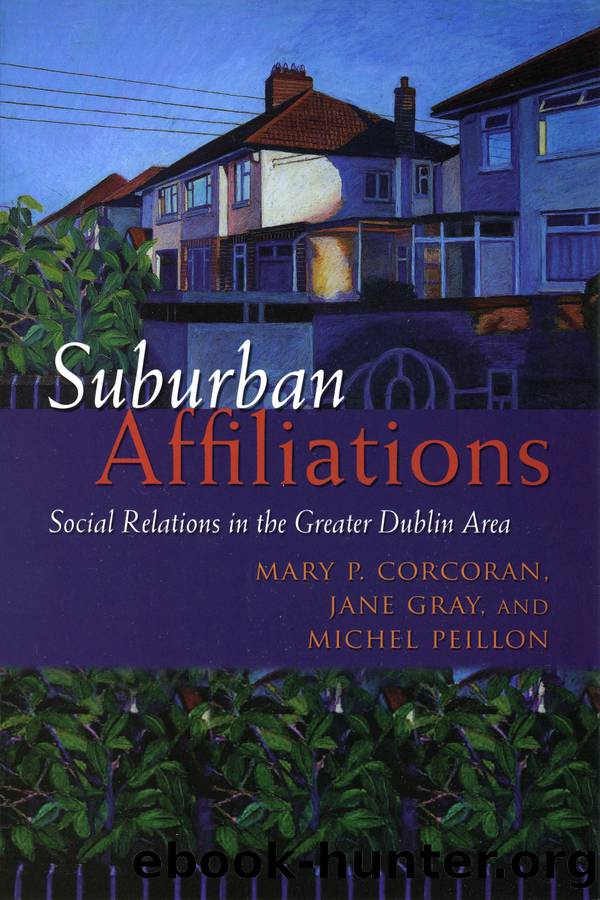Suburban Affiliations by Corcoran Mary P.;Gray Jane;Peillon Michel;

Author:Corcoran, Mary P.;Gray, Jane;Peillon, Michel;
Language: eng
Format: epub
Publisher: Syracuse University Press
Published: 2021-02-04T00:00:00+00:00
The kinds of concerns that adults expressed in the survey about the consequences of overdevelopment are mirrored in the childrenâs responses in the focus groups: âMullingar is getting a lot bigger, busier; traffic is heavier all around the place; the roads are getting dug up, a lot of houses, more peopleâ (focus group, St. Colmanâs National School, Mullingar). One child in Mullingar explained how difficult it is to access her friends in the estate. The estate had expanded at such a rate that people began using the roads as rat runs to get quickly from one end of the town to the other, causing traffic jams. Despite ramps being put in place and signs that stated the road is closed except to residents, cars continue to drive through: âItâs really hard to get out in the morning because they use it as a shortcut; they go through even if it says âroad closed.â And all the houses that are built like an estate on the road, and then thereâs houses down the field and everywhere, so itâs not safeâ (focus group, St. Colmanâs National School, Mullingar).
Childrenâs freedom to roam the neighborhood is much more curtailed today than it was in the past. As in the past, though, children derive considerable pleasure from making âpublic placesâ in the neighborhood their own. Green spaces that are appropriately configured within the design of new housing estates and that are managed well by local residents certainly play a significant part in generating an arena for sociability. However, lost through much of the development are the in-between or liminal âhanging-outâ spaces where children can escape from parental control. This loss is regrettable from the childrenâs point of view, but inevitable in developer-driven suburbs. The rural dream that the suburbs hold out for many parents (Bonner 1997) becomes somewhat hazy when the problems associated with the cityâtraffic, noise levels, pollution, and crimeâfollow them to the new idylls on the cityâs edge. A gap occurs between the âidealâ and the ârealâ suburb (Baldassare 1992, 479). Although the small, residential suburb with a country feel is preferred, most Irish suburbs (like their American counterparts) have been in transition to large, diverse places in sprawling and increasingly congested regions (Baldassare 1986). The children are having to face the reality that their suburbs are becoming urbanized, thus altering their lived experience of the localities and bringing the city closer to home.
ANTIURBAN IDEOLOGY
As we noted in chapter 1, a major motivation for people to move to the suburbs is the idea of escaping the city and its attendant problems. As John Palen points out, âthe suburban myth of the good life is predicated on urban ambivalence about, if not antagonism towards, cities and city lifeâ (1995, 93). What is remarkable is the extent to which this antiurban theme has been incorporated into the worldview of the children, though many were born in the city and maintain contacts there. They have developed a suburban sensibility that distances them from urban space. There
Download
This site does not store any files on its server. We only index and link to content provided by other sites. Please contact the content providers to delete copyright contents if any and email us, we'll remove relevant links or contents immediately.
| Anthropology | Archaeology |
| Philosophy | Politics & Government |
| Social Sciences | Sociology |
| Women's Studies |
Cecilia; Or, Memoirs of an Heiress — Volume 1 by Fanny Burney(32068)
Cecilia; Or, Memoirs of an Heiress — Volume 3 by Fanny Burney(31463)
Cecilia; Or, Memoirs of an Heiress — Volume 2 by Fanny Burney(31413)
The Great Music City by Andrea Baker(30794)
We're Going to Need More Wine by Gabrielle Union(18641)
All the Missing Girls by Megan Miranda(14767)
Pimp by Iceberg Slim(13787)
Bombshells: Glamour Girls of a Lifetime by Sullivan Steve(13692)
Fifty Shades Freed by E L James(12923)
Talking to Strangers by Malcolm Gladwell(12887)
Norse Mythology by Gaiman Neil(12847)
For the Love of Europe by Rick Steves(11544)
Crazy Rich Asians by Kevin Kwan(8894)
Mindhunter: Inside the FBI's Elite Serial Crime Unit by John E. Douglas & Mark Olshaker(8708)
The Lost Art of Listening by Michael P. Nichols(7169)
Enlightenment Now: The Case for Reason, Science, Humanism, and Progress by Steven Pinker(6878)
The Four Agreements by Don Miguel Ruiz(6324)
Bad Blood by John Carreyrou(6283)
Weapons of Math Destruction by Cathy O'Neil(5842)
